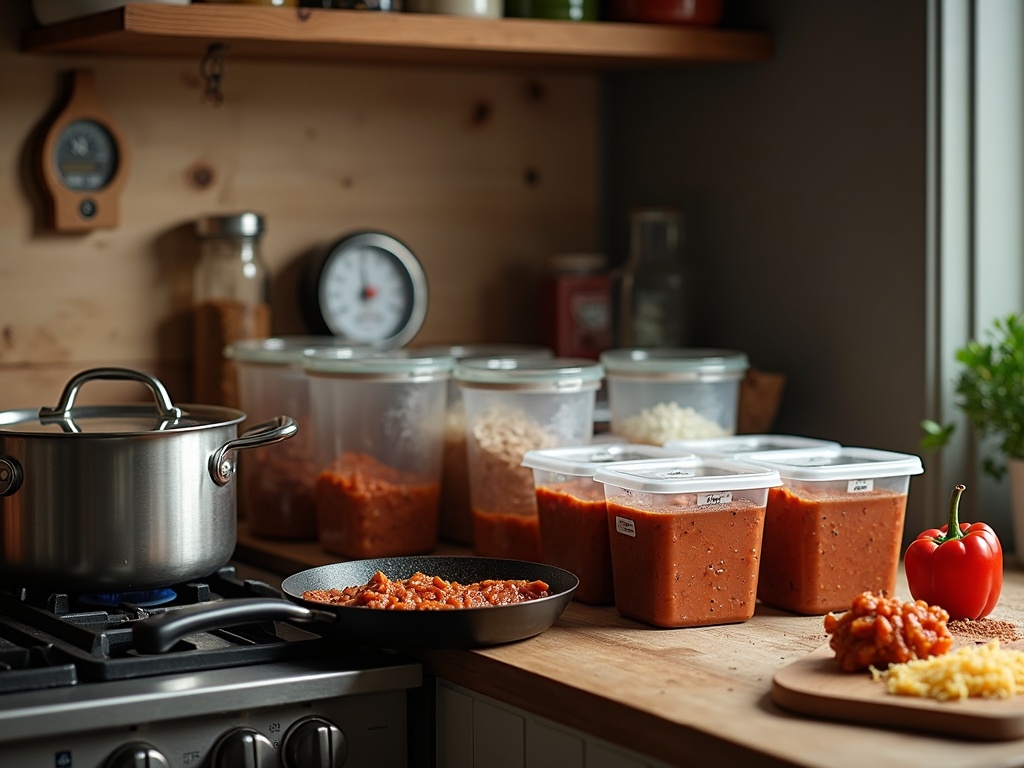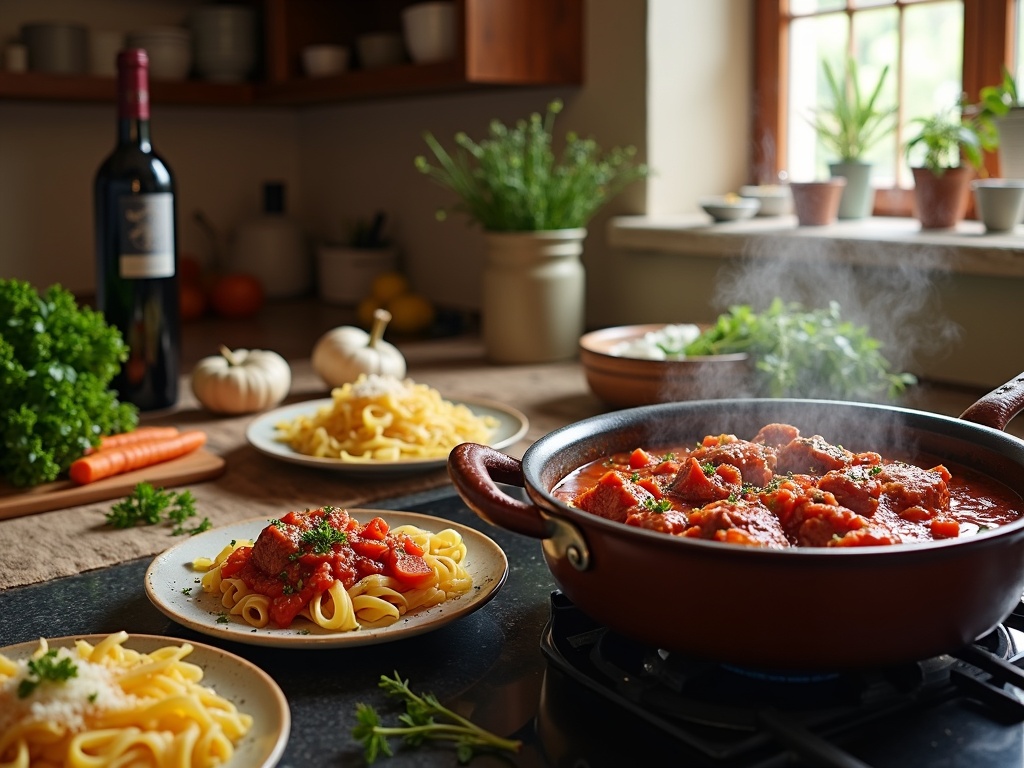Beef ragu, a cornerstone of Italian cuisine, combines tender shredded beef with a rich tomato-based sauce in a process that rewards patience with extraordinary flavor. The magic happens during hours of gentle simmering, when tough cuts like chuck or flank steak transform into melt-in-your-mouth meat that perfectly melds with the aromatic base of soffritto and red wine.
Find In This Article
Key Takeaways
- Authentic beef ragu requires specific cuts of meat (chuck roast or flank steak) that break down during slow cooking to create tender, flavorful results.
- The foundation begins with soffritto (sautéed onions, carrots, and celery), followed by proper meat searing and deglazing with red wine to build complex flavors.
- Regional variations exist across Italy, with northern versions featuring more meat, central preparations balancing meat and tomatoes, and southern versions incorporating more herbs.
- Wide pasta shapes like tagliatelle and pappardelle are ideal pairings as they provide perfect surfaces for the hearty sauce to cling to.
- Beef ragu can be refrigerated for 3-4 days or frozen for up to 3 months, making it excellent for meal prep and versatile repurposing in dishes beyond pasta.
What Makes an Authentic Beef Ragu
An authentic beef ragu holds a special place in Italian cuisine as a hearty, slow-cooked dish that combines tender, shredded beef with a rich tomato-based sauce. I’ve found that the magic of this dish lies in both its simplicity and the patience required to develop its complex flavors.
Essential Ingredients and Preparation
The foundation of a traditional ragu starts with the right cut of beef. Flank steak or chuck roast work perfectly because they break down beautifully during the slow cooking process. These tougher cuts transform into tender, flavorful meat that melts in your mouth when prepared correctly.
Every authentic ragu begins with a soffritto – the aromatic base consisting of finely diced onions, carrots, and celery sautéed until soft and fragrant. Garlic adds depth to this foundation, while tomatoes provide the distinctive tangy base. A splash of red wine isn’t just traditional – it’s crucial for deglazing the pan and adding complexity to the sauce.
Regional variations across Italy create distinctive interpretations of this classic dish:
- Northern Italian versions often feature less tomato and more meat
- Central Italian ragu typically balances tomatoes and meat more evenly
- Southern Italian preparations might include more herbs and spices
The cooking time makes all the difference in developing proper flavor. I’ve learned that a minimum of 3-4 hours of gentle simmering allows the beef to become perfectly tender while the sauce thickens and intensifies.
Nutritionally, a serving of beef ragu offers impressive benefits with approximately 300-400 calories and 20-25g of protein. It’s also rich in essential nutrients including vitamin B12, iron, and zinc – making it not just delicious but nourishing as well.
If you enjoy this hearty Italian classic, you might also appreciate trying a flavorful beef curry or a traditional beef goulash for similar comfort food experiences. For another slow-cooked beef option, a beef casserole offers many of the same satisfying qualities with different flavor profiles.
Master the Perfect Cooking Technique
Creating an amazing beef ragu requires patience and technique. I’ve found that following specific steps ensures rich, complex flavor and melt-in-your-mouth tenderness every time.
Building Layers of Flavor
The journey to an outstanding ragu begins with properly searing the meat. This crucial first step creates a flavorful crust through the Maillard reaction, which forms the foundation of your dish’s depth. I always ensure my beef chunks are patted dry and my pan is screaming hot before adding them – crowding the pan is the enemy of a good sear.
Next comes the soffritto – that magical flavor base of finely diced aromatic vegetables. Sautéing onions, carrots, and celery until they’re soft and fragrant creates an essential flavor platform for your beef ragu. I typically spend about 10 minutes on this step, allowing the vegetables to slowly release their sweetness.
The deglazing step shouldn’t be rushed. Adding red wine to the hot pan not only lifts those delicious browned bits from the bottom but introduces acidity and complexity. Let the wine reduce by half before moving forward – this concentrates the flavors and burns off the alcohol.
Temperature control makes all the difference when braising. I maintain a consistent 300-325°F throughout the cooking process. This gentle heat breaks down tough connective tissues without drying out the meat. For the perfect beef casserole consistency, plan on 2-3 hours of total cooking time.
Seasoning gradually throughout the cooking process is key. I add salt in stages rather than all at once:
- First when searing the meat
- Again when sautéing the soffritto
- Finally, a taste adjustment in the last 30 minutes of cooking
This approach prevents over-salting and allows the flavors to develop naturally. The tomatoes and wine already contribute significant flavor, so a gentle hand with salt works best.
I’ve discovered that occasionally stirring and checking the liquid level prevents the beef curry base from sticking or reducing too much. If the sauce becomes too thick during cooking, adding small amounts of beef stock maintains the perfect consistency without diluting flavor.
Remember that ragu continues developing flavor as it cools. If possible, make it a day ahead and reheat gently – the difference in taste is remarkable.

Serving Your Ragu Like an Italian Chef
The secret to transforming a good beef ragu into an extraordinary meal lies in how you serve it. I’ve found that choosing the right pasta, portioning correctly, and adding thoughtful garnishes can elevate this dish to restaurant quality.
Perfect Pasta Pairings
When serving a rich beef ragu, not just any pasta will do. Tagliatelle and pappardelle are ideal choices because their wide, flat shape provides the perfect surface for the hearty sauce to cling to. The robust texture of these pastas stands up beautifully against the substantial chunks of tender beef in the ragu.
For proper portioning, I recommend serving about 3/4 to 1 cup of ragu per person. This allows enough sauce to coat the pasta generously without overwhelming it. Remember that ragu should complement the pasta, not drown it.
To achieve that perfect al dente pasta texture that Italian chefs insist upon:
- Bring a large pot of heavily salted water to a rolling boil
- Add pasta and stir immediately to prevent sticking
- Cook for 1-2 minutes less than the package instructions suggest
- Reserve a cup of pasta water before draining
- Toss the pasta directly into your beef ragu, adding a splash of pasta water to help the sauce adhere
Essential Garnishes and Finishing Touches
The final touches make all the difference when serving a traditional beef ragu. Fresh, high-quality garnishes add both visual appeal and flavor complexity.
Fresh Parmesan cheese is the classic choice, shaved or grated over the top just before serving. For authentic alternatives, try Pecorino Romano for a sharper, saltier flavor, or explore regional Italian varieties like Grana Padano.
Fresh herbs bring brightness to the rich sauce – chopped parsley adds color and a clean flavor, while torn basil leaves contribute a sweet aromatic quality. A final drizzle of high-quality olive oil adds a silky finish and enhances the flavors.
For a complete meal, serve alongside a simple green salad dressed with lemon juice and olive oil, and some crusty bread to soak up any remaining beef curry recipe sauce. This balanced approach showcases the ragu as the star while providing complementary textures and flavors.
Create Delicious Variations
While I love the classic beef ragu recipe, there are countless ways to customize this hearty dish to suit different tastes, dietary needs, and ingredient availability.
Alternative Protein Options
The traditional beef base provides a robust flavor profile, but don’t hesitate to experiment with alternatives. Veal creates a more delicate version with a lighter texture while maintaining that satisfying depth of flavor. The tender meat breaks down beautifully during the slow cooking process, absorbing all those amazing aromatics. For those looking to boost their protein intake, beef ragu stands out as an excellent choice. It contains significantly higher protein content than simpler sauces like marinara – approximately 25g per serving compared to just 2g in tomato-based alternatives.
Not only does a good ragu deliver complete proteins, but it also provides an impressive vitamin and mineral profile. The combination of meat, vegetables, and herbs creates a nutritional powerhouse containing iron, zinc, B vitamins, and potassium essential for energy production and muscle function.
Dietary Adaptations
I’ve found several effective ways to modify beef ragu recipes for specific dietary requirements:
For gluten-free diets:
- Replace regular flour with rice flour or cornstarch when thickening the sauce
- Serve over gluten-free pasta alternatives like chickpea pasta or polenta
- Ensure all stock cubes or pre-made broths are certified gluten-free
Low-sodium versions are straightforward to create by:
- Using no-salt-added tomato products and fresh vegetables
- Substituting herbs and spices for salt
- Creating homemade stock rather than using store-bought versions
- Adding a splash of balsamic vinegar for flavor depth without the sodium
Regional adaptations make beef ragu incredibly versatile. Northern Italian versions might incorporate more dairy with a splash of cream, while southern interpretations lean heavier on tomatoes and chili. I often adjust ingredients based on what’s locally available – substituting local herbs like oregano for basil or incorporating regional vegetables that complement the rich sauce.
For an international twist, I sometimes borrow elements from other cuisines – adding curry spices for warmth or paprika for a Hungarian-inspired goulash variation. These adaptations keep the dish feeling fresh while maintaining its comforting essence.
Smart Storage Solutions
I’ve found that storing beef ragu properly is essential for maintaining its rich flavors and making the most of your cooking efforts. Whether you’re meal prepping or simply have leftovers, knowing how to store this hearty dish can save you time and reduce food waste.
Refrigeration and Freezing Tips
Your freshly made beef ragu will stay delicious in the refrigerator for 3-4 days when stored in an airtight container. For longer preservation, freezing is your best option, extending shelf life up to 3 months.
Before freezing, allow your ragu to cool completely at room temperature – but don’t leave it out for more than two hours. I’ve learned that proper cooling prevents those pesky ice crystals that can ruin texture. I divide my ragu into portion-sized containers to make defrosting easier.
When it’s time to reheat your beef ragu, gentle warming produces the best results. Low heat on the stovetop works wonderfully, stirring occasionally to ensure even heating. If using a microwave, short intervals with stirring between each one prevents overheating and texture damage.
For frozen portions, I add a splash of water or broth during reheating to restore moisture. This simple trick brings back the sauce’s silky consistency that might have been affected during freezing.
Don’t limit yourself to pasta when using leftover ragu. I’ve discovered several creative ways to repurpose this versatile sauce:
- Use as filling for stuffed bell peppers with a sprinkle of cheese on top
- Layer between pasta sheets for a quick beef casserole or lasagna
- Spoon over baked potatoes for a hearty lunch option
- Combine with rice for a risotto-inspired dish
- Create savory hand pies using puff pastry
These storage techniques and creative reuse ideas help maximize the value of your beef ragu recipe, turning one cooking session into multiple convenient meals throughout the week.

Sources:
“The Essentials of Italian Cooking” by Marcella Hazan
“Everyday Italian: 125 Simple and Delicious Recipes” by Giada De Laurentiis
“The Science of Good Cooking” by Cook’s Illustrated
NutritionData by Self.com

